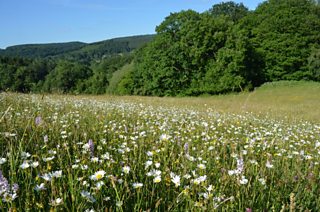By Ian Dunn, CEO, Plantlife
There is emerging scientific research that indicates that the soils underneath species-rich grasslands may be more important even than those under forests in offsetting our greenhouse gas emissions and that is why, ahead of the crunch COP climate talks taking place in Glasgow in just a few days, we are shining a bright light on the plight and potential of grasslands as never before.

Desire path through a meadow (c) Matt Pitts Plantlife
Together with our conservation partners and friends at Butterfly Conservation and Bumblebee Conservation we have set up , an energetic voice to speak up for grasslands, to shout from the rafters about both their unique value and vulnerability.
We know increasing tree cover is crucial if we are to get serious about tackling the climate emergency. Only 13% of the UK's total land area is covered in trees, compared with an average elsewhere in the EU of about 35%. In England, the figure is just 10%. For a teak-tough plan to address the climate crisis we need to enable the natural regeneration of trees alongside carefully planned woodland creation in our landscapes, and include many more trees in our urban areas.
But in the understandable and commendable rush to re-forest we must ensure that grassland habitats don’t get shaded out from the debate. We must never lose sight of the vitality of a varied and vivid patchwork of other habitats, alongside woodlands, that also lock down carbon and play home to a rich diversity of wild plants and fungi, and the wealth of wildlife they underpin.

A meadow up close (c) Matt Pitts Plantlife
Grasslands’ perilous plight is brought into particularly sharp focus when we consider wildflower meadows. A staggering 97% have been eradicated in the last century in the UK – equivalent to 7.5 million acres of wildflower habitat disappeared under the plough or bulldozer. It is estimated that 75% of the remaining meadows occur in small fragments and, due to poor protection, remain extremely vulnerable to destruction. Protecting these remaining biodiversity hotspots is a lifeline for bees: Plantlife research shows that one square metre of wildflower meadow in June is home to an average of 570 flowers on a single day. So one acre of wildflower habitat can contain over 2.3 million flowers. These flowers would produce around 6,700 tons of nectar sugar - enough to feed 621 billion bees per day.
It is sobering statistics like this that put a spring in my step as I prepare to attend COP alongside colleagues to press for the protection and restoration of species-rich grasslands to rise up the global political agenda. Permanent grasslands hold about a third of the Earth’s terrestrial carbon, meaning they simply cannot be overlooked when we talk about slowing climate change.

Joans Hill Farm (c) Joe Costley Plantlife
Thankfully the decline can be reversed through concerted conservation action. Plantlife is spearheading funded by the National Lottery Heritage Fund that is making more meadows across Cornwall, Cumbria, Devon, Sussex, Herefordshire, Lancashire, and Wiltshire. Anyone who has been lucky enough to enjoy the sights and sounds of a wildflower meadow buzzing with bees and butterflies will know these special grassy places are just too precious to let slip away for future generations.
